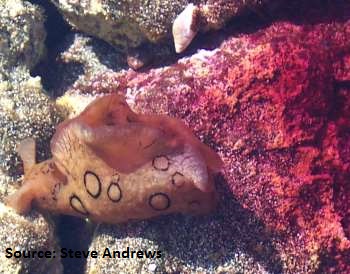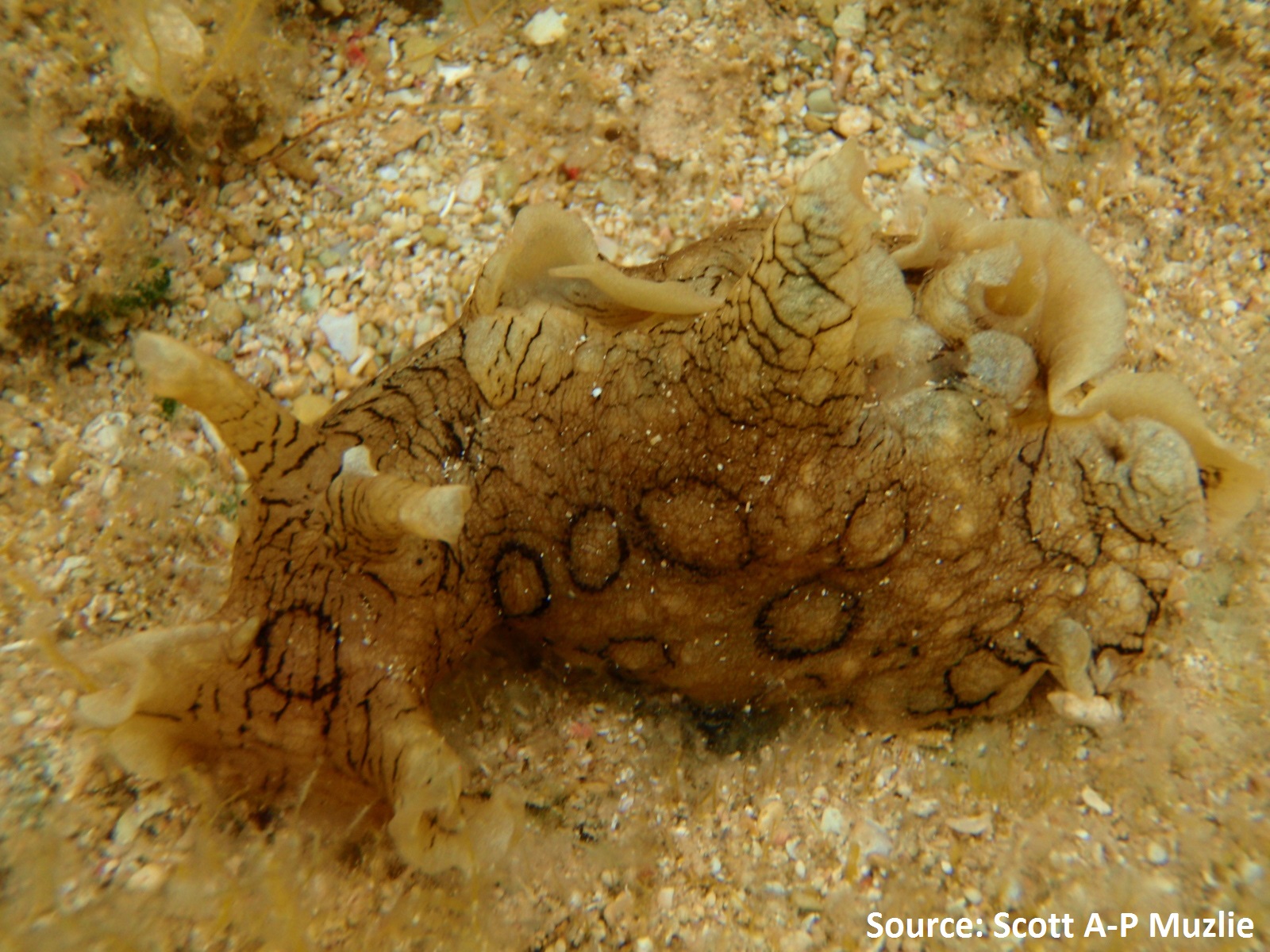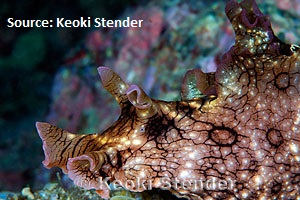
Interactions
Predators of Aplysia
dactylomela are essentially unknown which might seem odd
considering the speed at which the spotted sea hare would be able to
escape, the relative diversity of the animals ecosystem, and the
lack of hard protection, but like many other mollusks of its sort,
Aplysia dactylomela has a
wide array of chemical defenses instead of a hard shell. As a first line of defense, the sea
hare is able to release a toxic cloud of ink that deters potential predators (Carefoot et al.
1999). Created from a organ called the purple gland, the purple
pigment within the ink—and the body for that matter—is derived from
metabolites of the red algae portion of its diet. Selectively
feeding A. dactylomela a
diet of seaweeds and green algae produces no purple pigmentation in
the ink,
but the proteins that make up the toxicity of the smoke are still
present which suggests that A.
dactylomela is able to synthesize these proteins even without
red algae (Bezerra et al. 2004).
predators (Carefoot et al.
1999). Created from a organ called the purple gland, the purple
pigment within the ink—and the body for that matter—is derived from
metabolites of the red algae portion of its diet. Selectively
feeding A. dactylomela a
diet of seaweeds and green algae produces no purple pigmentation in
the ink,
but the proteins that make up the toxicity of the smoke are still
present which suggests that A.
dactylomela is able to synthesize these proteins even without
red algae (Bezerra et al. 2004).
Though some have
hypothesized that the ink offers a smoke screen effect that is
similar to that of octopi and other cephalopods, this seems very
unlikely given the speed at which the creature can escape, and
others believe that the ink could act depressing metabolism of
nearby creatures, reducing the ability to uptake oxygen (Carefoot
et al. 1999).
These hypothesizes both seem
less likely than that the ink simply acts as an irritant that
reduces appetite, disrupts senses, and encourages would be predators to find another
meal. For example, when confronted with a cloud of ink, species of
crab Mithrax sculptus and
Portunus spinimanus would
'slap' at the cloud and make a hasty retreat which testifies to its
toxicity and irritant qualities (Carefoot
et al. 1999). Crabs are
not the only species effected; most species that have been tested
seem to have some sort of negative reaction to ink, even some fellow
Opisthobranches. Beyond
the ink, Aplysia dactylomela, also seems to be distasteful which might deter
some potential predators. In addition to the irritant properties of
the toxic ink, the ink also repels predators through being
distasteful. Experimentally,
A. dactylomela would be fed on, but when introduced to ink, the
predators would back away (DiMatteo 1982).
Beyond the sensory disruption that the purple ink causes on
multicellular predators, interesting antibacterial properties can be
observed. When tested, the ink inhibits growth of all gram-negative
and gram-positive bacteria tested, but when removed from the ink,
the bacteria would begin growing once more (Melo
et. al 1998). This suggests that the ink does not kill bacteria but
simply puts it into a form of stasis that prevents the culture from
growth. Not similarly, no effect is observed on any of the tested
fungus (Melo et al. 1998).
gram-negative
and gram-positive bacteria tested, but when removed from the ink,
the bacteria would begin growing once more (Melo
et. al 1998). This suggests that the ink does not kill bacteria but
simply puts it into a form of stasis that prevents the culture from
growth. Not similarly, no effect is observed on any of the tested
fungus (Melo et al. 1998).
Because of the simple nature of sea hare's anatomy yet the complex chemicals produced by its ink, sea hares have gained increasing amounts of attention over the last few decades (Dionísio et al. 2013). The simplicity of the neural network allows for easy experimentation of specific nerve cells and ganglion and their role in behavior therefore they have become model organisms for those studying neurology (Encyclopedia of Life 2008). In addition, the antibacterial effects of A. dactylomela have garnered attention from the medical community as potential drugs (Dionísio et al. 2013)(Marine Invertebrates of Bermuda 2008).
Up next: See what other interesting facts exist about the spotted sea hare
